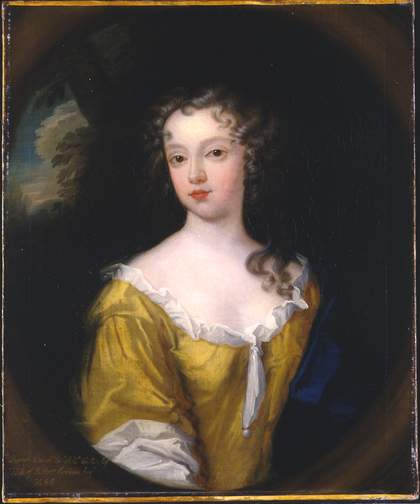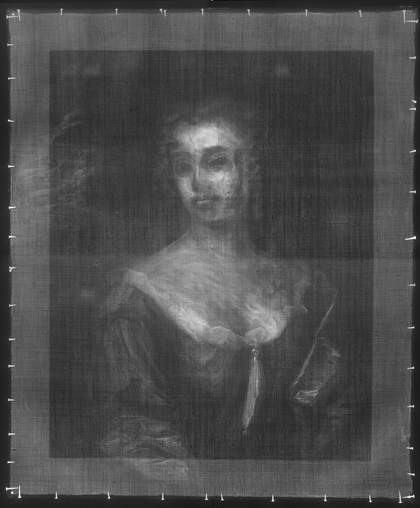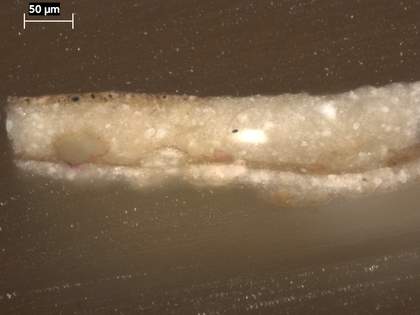
Fig.1
Haerman Verelst
Portrait of a lady, thought to be Dionesse Cullum, wife of Robert Colman
Tate
T07241

Fig.2
X-radiograph of Portrait of a lady, thought to be Dionesse Cullum, wife of Robert Colman
This painting is in oil paint on a single piece of plainly woven canvas measuring 750 x 630 mm (fig.1). Cusping of the canvas weave is discernible at the top and right edges in the X-radiograph but only very faintly at the left and bottom edges (fig.2).1 The tacking margins are no longer present. There are 9 horizontal threads and 13 vertical ones per square centimetre. The fabric is fairly coarse, the threads being thick and densely woven; the horizontal threads are consistently thicker than the vertical. There are two thick slubs, which are visible in the texture of the yellow costume. The painting is now lined with glue-paste adhesive onto a secondary linen canvas, stretched on a softwood strainer. Lines of cracking in the paint indicate that the original strainer or stretcher was a simple rectangle with bars 45 mm (1 ¾ in) wide.

Fig.3
Cross-section from the left spandrel at the top edge, photographed at x320 magnification. From the bottom: very thin coat of pale grey ground; coat of animal glue size, here stained reddish with acid fuchsin to identify protein; thicker application of ale grey ground; paint of spandrel

Fig.4
Cross-section of the sky at the top left edge, photographed at x 320 magnification. From the bottom: upper coat of pale grey ground; paint of sky
The ground is opaque, very pale grey, comprising two coats of a mixture of lead white, chalk and very finely ground black and a little red pigment (figs.3–4).2 The first coat was applied thinly to the canvas. It appears to have been sized with animal glue before the next, thicker coat was applied. There is no priming on top.
Both the X-radiograph and the infrared reflectogram (fig.5) show an artist’s alteration to the face; the sitter originally looked to our right. The catchlight of her left eye is visible with the unaided eye through the final paint layers at her left temple. Only the face and hair appear to have been altered significantly: there are minor adjustments to the neckline, where originally the spherical bauble hanging from the shift was further to our right, but otherwise the torso and arm remain unchanged.
The background and feigned oval were first laid in with thin reddish-brown oil paint, leaving reserve spaces for sky and the figure, although the same brown was used to sketch in the curls of hair; it remains visible there as the recessive tones. The dark blue cloak was laid in with a dark blue wash of indigo, after which the same blue made into two lighter shades with lead white. These were laid in wet-in-wet for the lighter areas, whereas pure indigo was applied thickly for the shadows. The whole of the white shift was painted wet-in-wet and left to dry before a mixture of yellow ochre, lead white and cologne earth was applied on top for the yellow bodice. The hanging bauble was added on top of the yellow.
The sky is composed of lead white mixed with indigo, chalk, bone black and ochres and glassy particles, perhaps pale smalt. The reddish-brown glaze on the spandrels is based on an aluminium-based, brown lake pigment (probably that known as brown pink) mixed with lead white, black, and very fine opaque red particles.

Fig.5
Infra-red reflectogram detail showing alterations in the face
September 2020
